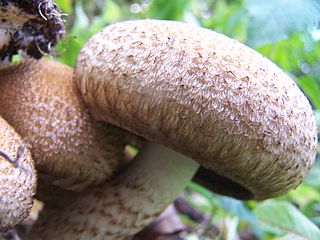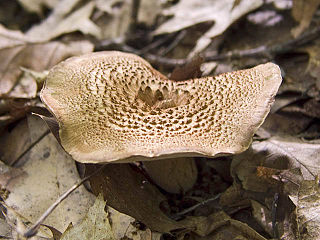
Hydnellum is a genus of tooth fungi in the family Bankeraceae. Widely distributed in the Northern Hemisphere, the genus contains around 40 species. The fruitbodies of its members grow by slowly enveloping nearby bits of grass and vegetation. There is great variability in the form of Hydnellum fruitbodies, which are greatly influenced by environmental conditions such as rainfall and humidity, drying winds, and temperature. They are too tough and woody to eat comfortably. Several species have become the focus of increasing conservation concern following widespread declines in abundance.

Phellodon is a genus of tooth fungi in the family Bankeraceae. Species have small- to medium-sized fruitbodies with white spines on the underside from which spores are released. All Phellodon have a short stalk or stipe, and so the genus falls into the group known as stipitate hydnoid fungi. The tough and leathery flesh usually has a pleasant, fragrant odor, and develops a cork-like texture when dry. Neighboring fruitbodies can fuse, sometimes producing large mats of joined caps. Phellodon species produce a white spore print, while the individual spores are roughly spherical to ellipsoid in shape, with spiny surfaces.

Steccherinum is a widely distributed genus of toothed crust fungi in the family Steccherinaceae.

Hydnellum ferrugineum, commonly known as the mealy tooth or the reddish-brown corky spine fungus, is a species of tooth fungus in the family Bankeraceae. A widely distributed species, it is found in north Africa, Asia, Europe, and North America. The fungus fruits on the ground singly or in clusters in conifer forest, usually in poor or sandy soil. Fruit bodies are somewhat top-shaped, measuring 3–10 cm (1–4 in) in diameter. Their velvety surfaces, initially white to pink, sometimes exude drops of red liquid. The lower surface of the fruit body features white to reddish-brown spines up to 6 mm long. Mature fruit bodies become dark reddish brown in color, and are then difficult to distinguish from other similar Hydnellum species. H. ferrugineum forms a mat of mycelia in the humus and upper soil where it grows. The presence of the fungus changes the characteristics of the soil, making it more podzolized.

Amanita albocreata, also called the ringless panther or the ringless panther amanita, is a species of fungus in the family Amanitaceae. It was discovered in 1944, by William Murrill. It is commonly found in northeastern United States and southeastern Canada and elsewhere in North America. This species, that grows about 5 to 15 centimeters in length, is doubted to be fatally toxic. It normally grows between the rainy months of June and August.

Phellodon sinclairii is a native tooth fungus found in beech forests of New Zealand. It was first described by Miles Joseph Berkeley in 1867 as a species of Hydnum in Joseph Dalton Hooker's work Handbook of the New Zealand Flora. The type locality was on Maungatua. Gordon Herriot Cunningham transferred the species to the genus Phellodon in 1958.

Phellodon tomentosus, commonly known as the zoned cork hydnum, is a species of tooth fungus in the family Bankeraceae. First described as Hydnum tomentosum by Carl Linnaeus in 1753, it was transferred to the genus Phellodon by Howard James Banker in 1906. It is found in Asia, Europe, and North America.

Psathyrella echiniceps is a species of agaric fungus in the family Psathyrellaceae. First described under the name Hypholoma echiniceps by George F. Atkinson in 1909, it was transferred to the genus Psathyrella by Alexander H. Smith in 1972. It is found in the US states of California, Idaho, Maryland, Michigan, New York, Ohio, Oregon, and Washington, where it grows in small groups around hardwood stumps.

Floccularia albolanaripes is a species of fungus in the family Agaricaceae. Mushrooms are characterized by their yellow caps with a brownish center and scales over the margin, and the conspicuous remains of a partial veil that is left on the stipe. The species grows in the Pacific Northwest and the Rocky Mountains of North America, and in India.
Hydnellum complicatum is a tooth fungus in the family Bankeraceae. Found in North America, it was described as new to science by mycologist Howard James Banker in 1906 from collections made in New York. Banker, who described the fruitbody as "irregular and complicated", considered it closely related to H. floriforme, differing in its reddish color and smaller spores.
Hydnellum earlianum, commonly known as Earl's hydnum, is a tooth fungus in the family Bankeraceae found in North America. It was described as new to science in 1906 by Howard James Banker from collections originally made in Georgia. The specific epithet honors mycologist Franklin Sumner Earle, "whose excellent field notes have frequently aided in the discrimination of species in this family".

Hydnellum cristatum is a tooth fungus in the family Bankeraceae found in Europe and North America. It was originally described as a species of Hydnum by Italian mycologist Giacomo Bresadola in 1902. Joost Stalpers transferred it to the genus Hydnellum in 1993.

Hydnellum scrobiculatum, commonly known as the ridged tooth, is a tooth fungus in the family Bankeraceae. Widely distributed in the Northern Hemisphere, it is found in Asia, Europe, and North America.
Phellodon plicatus is a species of tooth fungus in the family Bankeraceae. Found in Australia, it was first described in 1925 by Curtis Gates Lloyd as a species of Hydnum. Dutch mycologist Rudolph Arnold Maas Geesteranus transferred it to the genus Phellodon in 1966.

Phellodon atratus is a species of tooth fungus in the family Bankeraceae. Found in North America, it was described as new to science in 1964 by Canadian mycologist Kenneth A. Harrison. It occurs most frequently closer to the Pacific coast and under Sitka spruce.
Phellodon maliensis is a species of tooth fungus in the family Bankeraceae. Found in Australia, it was originally described as a new species by Curtis Gates Lloyd in 1923. It was originally placed in Hydnum, until Dutch mycologist Rudolph Arnold Maas Geesteranus transferred it to the genus Phellodon in 1966.

Phellodon niger, commonly known as the black tooth, is a species of tooth fungus in the family Bankeraceae, and the type species of the genus Phellodon. It was originally described by Elias Magnus Fries in 1815 as a species of Hydnum. Petter Karsten included it as one of the original three species when he circumscribed Phellodon in 1881. The fungus is found in Europe and North America, although molecular studies suggest that the North American populations represent a similar but genetically distinct species.

Hydnellum underwoodii is an inedible species of tooth fungus in the family Bankeraceae. Found in North America, it was described as new to science in 1906 by American mycologist Howard James Banker. Its reddish-brown, convex to flattened cap measures 5–14 cm (2.0–5.5 in) in diameter. Reddish-brown, partially erect scales adorn the cap surface. Spines on the cap underside are 1–3 mm long; they are initially white, becoming brown with grayish tips in age. The oval to spherical spores are 6–7.5 by 5.5–6.5 µm. The fungus fruits singly or scattered, on the ground in coniferous forests.

Phellodon confluens, commonly known as the fused cork hydnum, is a species of tooth fungus in the family Bankeraceae. It was originally described in 1825 as Hydnum confluens by Christiaan Hendrik Persoon. Czech mycologist Zdenek Pouzar transferred it to the genus Phellodon in 1956. The fungus is found in Asia, Europe, and North America. It is considered vulnerable in Switzerland.

Phellodon melaleucus, commonly known as the grey tooth, is a species of tooth fungus in the family Bankeraceae. It was originally described by Elias Magnus Fries in 1815 as a species of Hydnum. In 1881, Petter Karsten included it as one of the original three species in his newly circumscribed genus Phellodon. The fungus is widely distributed in Europe and North America, where it associates mycorrhizally with a wide range of host trees. It is considered vulnerable in Switzerland.














